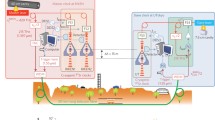Abstract
We report on the experimental results of testing a new physical method of determination of the gravitational potential differences and orthometric heights by measuring the relativistic effect of gravitational redshift of frequency by means of atomic clocks. The experiment was performed in the Altai Mountains between two geodetic stations, Shebalino and Sieminski Pass, separated by about 850 meters in altitude. The measured mean value of the frequency shift caused by the change in the gravitational potential between the two stations is (δf/f 0)grav = 7.980 × 10−14, with the dispersion σ f = 7.27 × 10−15 referred to the time interval of the experiment.
Similar content being viewed by others
References
L. D. Landau and E. M. Lifshitz, Theory of Fields (Nauka, Moscow, 1988).
S. Kopeikin, M. Efroimsky, and G. Kaplan, Relativistic CelestialMechanics of the Solar System (Wiley, Berlin, 2011).
Y. Ovchinnikov and G. Marra, “Accurate rubidium atomic fountain frequency standard,” Metrologia 48, 87–100 (2011).
B. J. Bloom, T. L. Nicholson, J. R. Williams, S. L. Campbell, M. Bishof, X. Zhang, W. Zhang, S. L. Bromley, and J. Ye, “An optical lattice clock with accuracy and stability at the 10-18 level,” Nature 506, 71–75 (2014).
G. Petit, P. Wolf, and P. Delva, “Atomic time, clocks, and clock comparisons in relativistic spacetime: a review,” in Frontiers in Relativistic Celestial Mechanics. Vol. 2. Application and Experiments. Ed. by S. M. Kopeikin (De Gruyter, Berlin, 2014), pp. 249–283.
E. Mai, Time, Atomic Clocks, and Relativistic Geodesy’ (Deutsche Geodätische Kommission, München, 2013); http://www.dgk.badw.de/fileadmin/docs/a-124.pdf. Cited February 21, 2016.
V. F. Fateev and V. P. Sysoev, “Relativistic effects in mobile clocks,” Meas. Techniques 8, 31–35 (2014).
P. Gill, H. Margolis, A. Curtis, H. Klein, S. Lea, S. Webster, and P. Whibberley, Optical Atomic Clock for Space, (National Physical Laboratory of USA, Technical Supporting Document, 2008); http://www.npl.co.uk/upload/pdf/atomic_clocks_space.pdf. Cited February 21, 2016.
N. Ashby, “Relativity in the Global Positioning System,” Living Rev. Relativity 6, 1 (2003); http://www.livingreviews.org/lrr-2003-1. Cited February 21, 2016.
G. F. Tulinov, “Radiophysical method of measurement of the Earth’s gravitational potential: the state of the art and future prospects,” Heliophysical Research 6, 91–95 (2013); http://vestnik.geospace.ru/index.php?id=62. Cited February 21, 2016.
L. A. Lipatnikov, “Relativistic effects in the clocks of GNSS reseivers,” Proceedings of Siberian State Geodesic Academy 3, 45–52 (2011).
S. Turyshev, “Experimental tests of general relativity,” Annual Review of Nuclear and Particle Systems 58 (1), 207–248 (2008).
C. M. Will, “The Confrontation between General Relativity and Experiment,” Living Rev. Relativity 9, 3 (2006); http://www.livingreviews.org/lrr-2006-3. Cited February 21, 2016.
J. C. Hafele and R. E. Keating, “Around-the-world atomic clocks: predicted relativistic time gains,” Science 177 (4044), 166–168 (1972).
J. C. Hafele and R. E. Keating, “Around-the-world atomic clocks: observed relativistic time gains,” Science 177 (4044), 168–170 (1972).
S. Iijima, K. Fujiwara, H. Kobayashi, and T. Kato, “An experiment for the potential blue shift at the Norikura Corona Station,” Annals of the Tokyo Astronomical Observatory 17, 680–78 (1978).
L. Briatore and S. Leschiutta, “Evidence for the Earth gravitational shift by direct atomic-time-scale comparison,” Nuovo Cim. B 37 (2), 219–231 (1977)
C. W. Chou, D.B. Hume, T. Rosenband, and D. J. Wineland, “Optical clocks and relativity,” Science 329 (5999), 1630–1633 (2010).
C. Lisdat and P. O. Schmidt, “Transportable optical clocks for relativistic geodesy,” Leibniz Universität Hannover, Project SFB 1128, Research Area A03, 2016; http://www.geoq.uni-hannover.de/a03.html. Cited February 21, 2016.
V. M. Tissen and A. S. Tolstikov, “Mathematical models of KSCH instability,” in Proc. Int. Conf. “Important Problems of Electronic Engineering: IPEE–2004” (Novosibirsk State University, Novosibirsk, 2004), vol. 3, pp. 263–269.
J. Rutman, “Characterization of phase and frequency instabilities in precision frequency sources—Fifteen years of progress,” Proc. IEEE 66, 1048–1075 (1978).
V. F. Eremeev and M. I. Yurkina, Theory of Heights in the Earth’s Gravitational Field (Nedra,Moscow, 1972)
F. V. Kushnir, Electro-radiomeasurements, Textbook for the Schools of Higher Learning (Energoatomizdat, Leningrad, 1983).
D. E. Wells, N. Beck, D. Delikaraoglou, A. Kleusberg, E. J. Krakiwsky, G. Lachapelle, R. B. Langley, M. Nakiboglu, K. P. Schwarz, J. M. Tranquilla, and P. Vanicek, Guide to GPS Positioning (Canadian GPS Associates: Fredericton, N.B., Canada, 1986); http://plan.geomatics.ucalgary.ca/papers/guide_to _gps_positioning_ebook.pdf. Cited February 21, 2016.
A. S. Tolstikov, “Algorithms of synchronization of spatially separated clocks by means of the signals of the satellite positioning systems,” Metrology 9, 25–35 (2009).
K. M. Antonovich and N. S. Kosarev, “On the divergence of the range and phase pseudo-distances,” in: Proceedings of IX-th International Scientifi Congress “InterExpo Geo-Siberia 2013” (Siberian State Geodesic Academy, Novosibirsk, 2013), vol. 3, pp. 60–66.
J. Boehm, A. Niell, P. Tregoning, and H. Schuh, “Global Mapping Function (GMF): A new empirical mapping function based on numerical weather model data,” Geophys. Res. Letters 33, L07304 (2006).
V. F. Kanushin, A. P. Karpik, D. N. Goldobin, I. G. Ganagina, E. G. Gienko, and N. S. Kosarev, “Determination of the differences of the gravitational potential and heights in geodesy by means of gravimetric and satellitemeasurements,” in Proc. Siberian State University of Geosyststems and Technology (2015), vol. 3, pp. 53–69.
C. Förste, S. Bruinsma, O. Abrikosov, F. Flechtner, J.-C. Marty, J.-M. Lemoine, C. Dahle, H. Neumayer, F. Barthelmes, R. König, and R. Biancale, “EIGEN-6C4—The latest combined global gravity field model including GOCE data up to degree and order 1949 of GFZ Potsdam and GRGS Toulouse,” in EGU General Assembly Abstracts, 2014, No. 3707.
Author information
Authors and Affiliations
Corresponding author
Rights and permissions
About this article
Cite this article
Kopeikin, S.M., Kanushin, V.F., Karpik, A.P. et al. Chronometric measurement of orthometric height differences by means of atomic clocks. Gravit. Cosmol. 22, 234–244 (2016). https://doi.org/10.1134/S0202289316030099
Received:
Published:
Issue Date:
DOI: https://doi.org/10.1134/S0202289316030099




